Is there a fan that really uses less power? If that's true, why is the electric price so high?
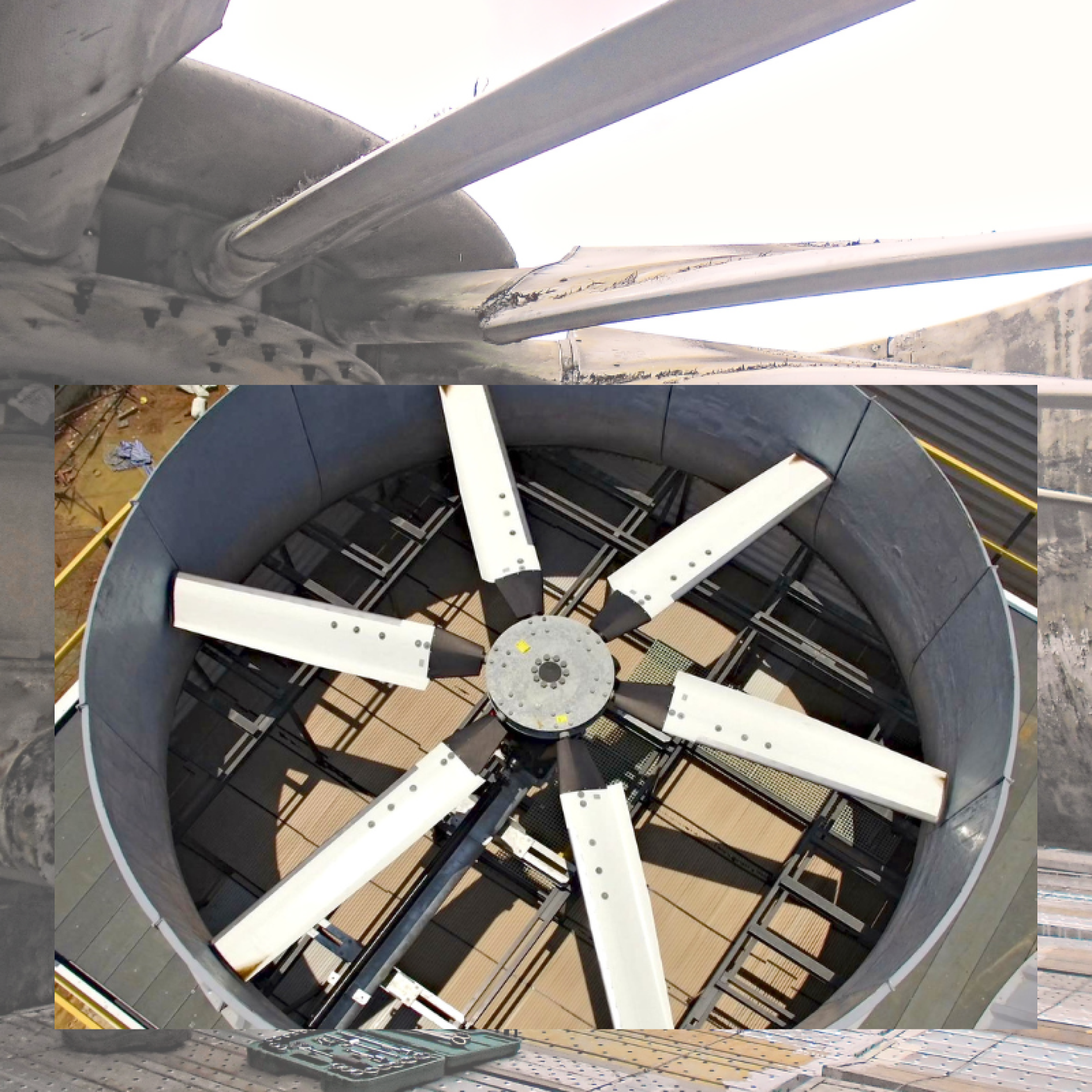
We've written a lot about cooling towers, fill packs, and gear boxes in the past. Our articles have garnered a lot of positive feedback. People frequently send us messages. Inquiries come in from time to time. Quite a few fascinating issues were raised. It's always exciting to receive inquiries that spark curiosity and encourage further exploration. I look forward to delving deeper into these intriguing questions and providing insightful answers.
The cooling tower's fans, or "fan blades" as they are sometimes referred to. This component is one of the most power-intensive in a cooling tower, which is why many manufacturers and cooling tower service providers are investing resources in developing and promoting energy-efficient fan blades.
Despite the availability of numerous energy-saving fans in the market, the electricity costs of many businesses that rely on cooling towers remain high. This raises an interesting question that we will delve into today: Is there really such a thing as an energy-saving fan?
Today's article may contain a great deal of technical detail. But I'll try to keep things as straightforward as possible so that everyone can follow along.
For the benefit of those who aren't already familiar with us, let me take a moment to formally introduce ourselves.
Innovek Asia, Thailand's main manufacturer of cooling towers, offers only those goods that meet or exceed all applicable international standards. For more than 15 years, our team has been satisfying customers with first-rate support and services. We take care of everything, from conception to implementation, and that includes making sure your cooling towers are inspected and serviced regularly. We serve customers all across the world.
Since we're already acquainted, we can resume our discussion.
Let's begin our discussion with aerodynamics. If you're not familiar with the term, it refers to the study of how air interacts with objects in motion, with the goal of understanding how those objects move through the air. Having a deep understanding of this field can help us grasp the forces that come into play during flight, such as lift and drag. The knowledge gained from studying aerodynamics can be applied in a variety of fields, from aviation to sports.
Originally developed by engineers to ensure the safe operation of aircraft and airplanes, this principle has since been extended to other industries, including automotive engineering. The concept has also found use in the cooling tower industry, particularly in relation to the design of cooling tower fans.

The images described above serve as inputs for Computerized Fluid Dynamics (CFD) software, which is utilized to analyze fluid flow. The central dark green ellipse in the images represents the fan, while the small arrow indicates the direction of the wind. In Picture 1 and Picture 2, two different types of fan blades are subjected to airflow.
It is important to pay attention to the tail end of both fans. Picture 1 shows that there are many curved arrows at the end of the fan blades, indicating a high level of turbulence. In contrast, Picture 2 also displays some turbulence, but to a considerably lesser extent.
The amount of turbulence has a significant impact on energy consumption. In this example, the fan depicted in Picture 1 consumes more energy than the one in Picture 2, due to the increased turbulence present in the former.
In the past, cooling towers were equipped with fans that consumed a great deal of energy due to their inefficient design. These outdated fans produced a lot of turbulence, leading to a significant amount of energy waste. However, many companies have been hard at work developing and refining new models. The goal? To create fans that operate with greater efficiency, resulting in reduced power consumption and improved performance.
Upon comparing data sheets for older and newer cooling tower fans, a clear difference emerges. Older models, even when running at full capacity, can only achieve a maximum efficiency of 70%. In contrast, modern fans that are properly selected and installed can reach impressive levels of efficiency, ranging from 83% to 90%.
If you're curious about how we arrived at the maximum efficiency of our fans, the process is actually quite technical. There's a specific formula that we use to calculate the efficiency of a fan based on its energy consumption.
In the past, this formula had to be calculated by hand using a set of equations. However, nowadays, the calculations are more commonly done with the help of specialized software. It's worth noting, though, that understanding the formula is still important in case you ever find yourself without access to this software.
Efftotal = TP x ACFM ÷ (6356 x BHP)
In which, TP = total pressure
ACFM = actual air flow in CFM
BHP = brake horse power หรือ ค่าพลังงานที่ใช้ในการขับเคลื่อนใบพัด
If you want to improve the efficiency of your cooling tower fans, there are a few methods you can try.
1. Reduce the vortex
1.1 The vortex that occurs at the tip of the fan
When we talk about the swirling air at the end of a fan, we refer to something called the tip vortex. This vortex can actually reduce the fan's performance, but fortunately there is a technique we can use to minimize its impact. By installing a wind barrier at the tip of the fan, which is commonly known as a tip cap, we can decrease the vortex and improve the fan's efficiency. In fact, using a tip cap can help reduce wind loss by up to 2-3%.
To get a better sense of what a tip cap looks like, take a look at the image below. In the picture, you'll notice that the tip cap is represented by the blue piece at the end of the fan.
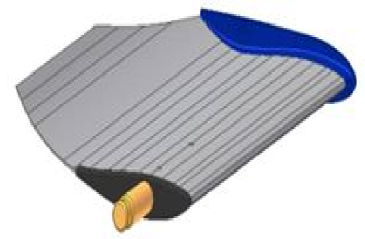
The swirling vortex located in the center of the fan is what we refer to as "hot air recirculation." This phenomenon results in wasted energy and a decrease in the fan's efficiency in pulling in the necessary wind for cooling. Fortunately, there is a solution: attaching a seal disc to the center of the fan can prevent this from happening.
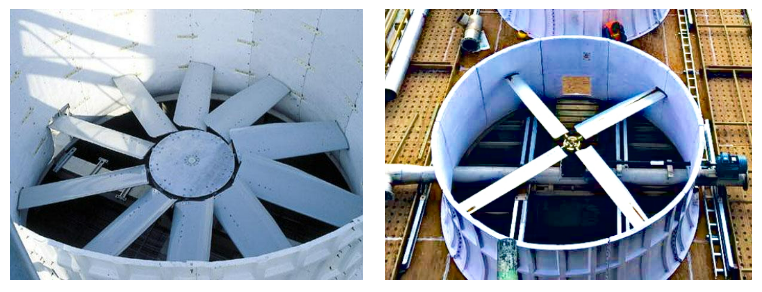
Now, let's examine how a fan blade performs with the addition of a Seal disc and Tip cap compared to a fan blade without either of these components. By analyzing its development, we can gain insights into the effectiveness of these features.
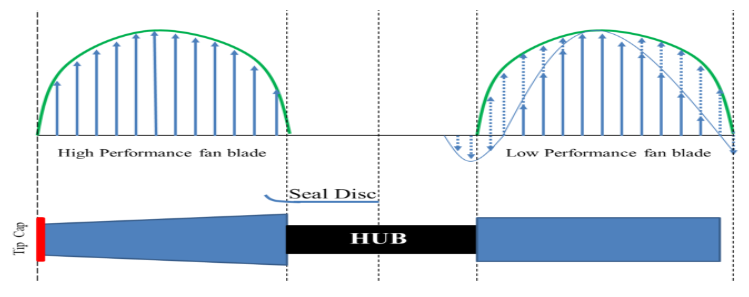
Picture 5 The fan with Seal disc, Tip cap installed (left picture)
and the fan without Seal disc, Tip cap (right picture)
2. Using Energy saving fan
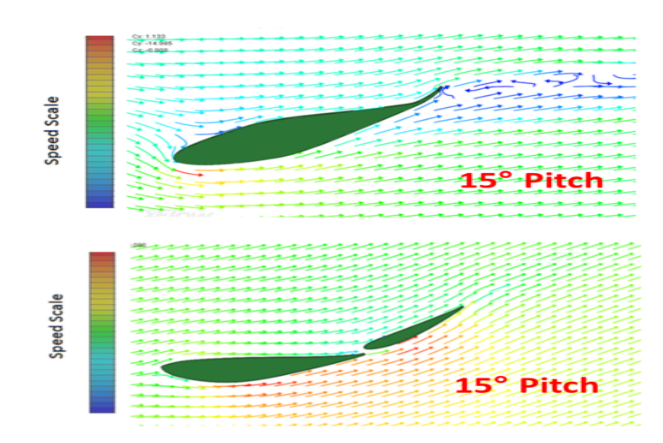
Picture 6 A computational fluid dynamics (CFD) simulation showing the wind's course as it strikes the original (top) and improved (bottom) versions of the fan
More turbulence or wind flow is created at the fans tip in older designs, as seen in this image. The manufacturers go even further by splitting the blade into two parts, as shown in the bottom of picture 6. Like an airplane wing, a split propeller provides a Venturi effect, allowing air to flow more smoothly than it would around a whole fan, increasing the fan's efficiency in steadier winds.
As you've made it this far in the article, it's safe to assume that you're already aware of the existence of energy-saving fans. However, it's important to note that the actual amount of energy that can be saved depends on various factors, such as the type of propeller used, the cooling tower provider, and the proficiency in assessing computations.
But, before we conclude this article, there's one more point that's worth mentioning. You might be curious if there's a way to verify the claims made by cooling tower service providers that adjusting fan blades can result in a savings of up to a certain amount. To help you better understand this, let me provide an example.
Imagine you own a business that relies on a cooling tower, and the company that services your tower is trying to sell you a new energy-saving fan. They claim that the new fan, once installed, will be over 80% more efficient than your current fan and can save you 30% on energy costs.
While its common knowledge that the equation Efftotal = TP x ACFM ÷ (6356 x BHP) is used to determine a fans efficiency, lets take a different approach for a moment. In this case, well start by determining the energy consumption of a fan with an efficiency rating of 80%. To do so, well use a different formula, specifically BHP = TP x ACFM ÷ (Eff x 6356)
In this case of this particular fan, its efficiency rating is 80%, or Eff = 0.8
ACFM which means the air flow value is 1,200,000 CFM
The total pressure, or TP, is at 0.736 InchH2O
(The air flow value can be measured directly at the propeller or found in the product data sheet.)
Substitute the values we have into the equation;
BHP = TP x ACFM ÷ (Eff x 6356)
BHP = 0.736 x 1,200,000 ÷ (0.8 x 6356)
BHP = 173.6
After analyzing the data, let say that this particular fan utilized 173.6 BHP to operate its blades. However, suppose we take into account the manufacturer's claim of a 30% reduction in power consumption. In that case, we must subtract this percentage from the total BHP, resulting in a new figure of 121.58 BHP.
To determine the fan's efficiency when operating at 121.58 BHP, we can input these values into the efficiency total equation
Efftotal = TP x ACFM ÷ (6356 x BHP)
Eff = 0.736 x 1,200,000 ÷ (6356 x 121.58)
Eff = 114%
In conclusion, the seller's claim that an 80% efficient fan can help you save up to 30% is not supported by the data, since a fan with efficiency of up to 114% is required to achieve the same reduction in energy usage.
While these problems can be quite complex and difficult to fully understand, it's important that we approach them with sensitivity and careful consideration. Continuously seeking out new ways to expand our knowledge is always a worthwhile pursuit, as it can protect us from being taken advantage of by unscrupulous service providers. Personally, I believe that the cost of giving up on learning and limiting our potential for growth is a loss that we cannot even begin to comprehend.
I truly hope that you have found this article valuable. If you have any questions about cooling towers or if you would like to suggest a topic for our next article, please don't hesitate to reach out to us at coolingexpert@innovek.co.th. We are always happy to help and offer our expertise free of charge.
At the moment, we do not have a system in place to notify site users when new content is added. However, you can stay updated by following our Facebook page by clicking here. If you encounter any issues locating our page, try searching for "Innovek Asia" on Facebook. Don't miss out on our latest articles!








